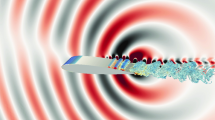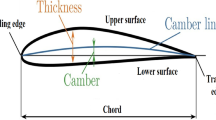Abstract
Rotor load predictions of the UH-60A helicopter in low-speed flights are validated using nonlinear flexible multibody dynamic analyses with multiple wake panels. A nonlinear flexible multibody dynamic analysis code, DYMORE II, is used for predicting the blade section airloads and structural loads of the UH-60A rotor in low-speed forward and descending flights at the advance ratio of 0.15. The freewake model with multiple wake panels is integrated implicitly into DYMORE II to represent effectively the BVI (blade–vortex interaction) phenomenon of the rotor in low-speed flights. For both low-speed forward and descending flights, the multiple wake panel and single wake panel models both validate the blade section normal forces (or lift forces) moderately or well with the flight test data; however, they predict the blade section pitching moments moderately or poorly. For blade structural loads, two analyses using the multiple wake panel and single wake panel models validate the oscillatory flap bending moments moderately for both flight conditions; however, they correlate the oscillatory lead–lag bending moments poorly with the measured data. In addition, the multiple wake panel and single wake panel models both validate the oscillatory torsion moment well for the low-speed descending flight; but they predict it moderately or poorly for the low-speed forward flight. Through the present study, the analyses using multiple wake panels show better predictions of the rotor loads in low-speed flights as compared to the results with a single wake panel, along with efficient and reasonable computation resource and time.















Similar content being viewed by others
Abbreviations
- C T :
-
Rotor thrust coefficient
- C T/σ :
-
Rotor thrust coefficient divided by solidity
- R :
-
Rotor radius (ft)
- r :
-
Radial location (ft)
- α s :
-
Rotor shaft angle (°) (positive for aft tilt)
- σ :
-
Rotor solidity
- ψ :
-
Azimuth angle (°)
- Ω :
-
Rotation speed of a rotor, RPM or rad/s
- μ :
-
Advance ratio
References
Bauchau OA (2006) DYMORE solutions: simulation tools for flexible multibody systems, http://www.dymoresolutions.com. Accessed 1 Mar 2018
Mantegazza P (2018) MBDYN: free multibody dynamics simulation. https://www.mbdyn.org/. Accessed 1 Mar 2018
Peters DA, He CJ (1995) Finite state induced flow models part II: three-dimensional rotor disk. J Aircr 32(2):323–333
Liu H (2008) Interfacing comprehensive rotorcraft analysis with advanced aeromechanics and vortex wake models. Ph.D Thesis, School of Aerospace Engineering, Georgia Institute of Technology
Abras JN (2009) Enhancement of aeroelastic rotor airload prediction method. Ph.D Thesis, School of Aerospace Engineering, Georgia Institute of Technology
Rajmohan N (2010) Application of hybrid methodology to rotors in steady and maneuvering flight. Ph.D Thesis, School of Aerospace Engineering, Georgia Institute of Technology
Park JS, Sa JH, Park SH, You YH, Jung SN (2013) Loosely coupled multibody dynamics-CFD analysis for a rotor in descending flight. Aerosp Sci Technol 29(1):262–276
Roget B (2006) Simulation of active twist and active flap control on a model-scale helicopter rotor. In: 24th AIAA applied aerodynamics conference
Park JS, Jung SN (2012) Comprehensive multibody dynamics analysis for rotor aeromechanics predictions in descending flight. Aeronaut J 16(1177):229–249
Park JS (2014) Multibody analyses for performance and aeromechanics of a rotor in low-speed flight. Aircr Eng Aerosp Technol 86(1):33–42
Bousman WG, Kufeld RM (2005) UH-60A Airloads catalog NASA TM-2005-212827
Yeo H, Potsdam M (2014) Rotor structural loads analysis using coupled computational fluid dynamics/computational structural dynamics. In: The American Helicopter society 70th annual forum
Lim JW, Nygaard TA, Strawn R, Potsdam M (2006) BVI airloads prediction using CFD/CSD loose coupling. In: The American Helicopter Society 4th vertical lift aircraft design conference
Potsdam M, Wissink A, Kamkar S, Jayaraman B (2011) CFD adaptive mesh refinement for rotorcraft wake simulation. In: 37th European rotorcraft forum
Potsdam M, Yeo, H, Johnson W (2004) Rotor airloads prediction using loose aerodynamic/structural coupling. In: The American Helicopter Society 60th annual forum
Ho JC, Yeo H, Ormiston RA (2008) Investigation of rotor blade structural dynamics and modeling based on measured airloads. J Aircr 45(5):1631–1642
Anusonti-Inthra P (2010) Validations of coupled CSD/CFD and particle vortex transport method for rotorcraft applications: hover, transition, and high speed flights. In: The American Helicopter Society 66th annual forum
Lim JW, van der Wall BG (2005) Investigation of the effect of a multiple trailer wake model for descending flights. In: The American Helicopter Society 61st Annual Forum
Lim JW (2008) An assessment of rotor dynamics correlation for descending flight using CFD/CSD coupled analysis. In: The American Helicopter Society 64th annual forum
Yeo H (2013) Investigation of UH-60A rotor performance and loads at high advance ratios. J Am Helicopter Soc 50(2):576–589
Bhagwat MJ (2001) Mathematical modeling of the transient dynamics of helicopter rotor wakes using a time-accurate free-vortex method. Ph.D Thesis, Department of Aerospace Engineering, University of Maryland
Squire HB (1965) The growth of a vortex in turbulent flow. Aeronaut Q 16:302–306
Peters DA, Barwey D (1965) A general theory of rotorcraft trim. Math Probl Eng 2(1):1–34
Acknowledgements
This work was supported by Basic Science Research Program through the National Research Foundation of Korea (NRF) funded by the Ministry of Science, ICT, and Future Planning (NRF-2016R1C1B1007199).
Author information
Authors and Affiliations
Corresponding author
Rights and permissions
About this article
Cite this article
Park, JS. Validations of Rotor Load Analysis Using Flexible Multibody Dynamics with Multiple Wake Panels for Low-Speed Flights. Int. J. Aeronaut. Space Sci. 19, 863–877 (2018). https://doi.org/10.1007/s42405-018-0070-y
Received:
Revised:
Accepted:
Published:
Issue Date:
DOI: https://doi.org/10.1007/s42405-018-0070-y




